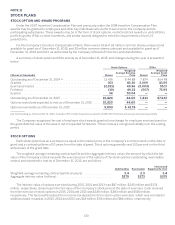American Express 2015 Annual Report Download - page 147
Download and view the complete annual report
Please find page 147 of the 2015 American Express annual report below. You can navigate through the pages in the report by either clicking on the pages listed below, or by using the keyword search tool below to find specific information within the annual report.
FAIR VALUE HEDGES
A fair value hedge involves a derivative designated to hedge the Company’s exposure to future changes in the fair
value of an asset or a liability, or an identified portion thereof, that is attributable to a particular risk.
Interest Rate Contracts
The Company is exposed to interest rate risk associated with its fixed-rate long-term debt. The Company uses
interest rate swaps to economically convert certain fixed-rate debt obligations to floating-rate obligations at the time
of issuance. As of December 31, 2015 and 2014, the Company hedged $18.8 billion and $17.6 billion, respectively, of its
fixed-rate debt to floating-rate debt using interest rate swaps.
To the extent the fair value hedge is effective, the gain or loss on the hedging instrument offsets the loss or gain on
the hedged item attributable to the hedged risk. Any difference between the changes in the fair value of the derivative
and the hedged item is referred to as hedge ineffectiveness and is reflected in earnings as a component of Other
expenses. Hedge ineffectiveness may be caused by differences between a debt instrument’s interest coupon and the
benchmark rate, primarily due to credit spreads at inception of the hedging relationship that are not reflected in the
valuation of the interest rate swap. Furthermore, hedge ineffectiveness may be caused by changes in the relationship
between 3-month LIBOR and 1-month LIBOR, as well as between the overnight indexed swap rate (OIS) and 1-month
LIBOR, as spreads between these rates may impact the valuation of the interest rate swap without causing an
offsetting impact in the value of the hedged debt.
If a fair value hedge is de-designated or no longer considered to be effective, changes in fair value of the derivative
continue to be recorded through earnings but the hedged asset or liability is no longer adjusted for changes in fair
value resulting from changes in interest rates. The existing basis adjustment of the hedged asset or liability is
amortized or accreted as an adjustment to yield over the remaining life of that asset or liability.
Total Return Contract
The Company hedged its exposure to changes in the fair value of its equity investment in ICBC in local currency.
The Company used a TRC to transfer its exposure to its derivative counterparty. On July 18, 2014, the Company sold
its remaining shares in ICBC and terminated the TRC.
The following table summarizes the impact on the Consolidated Statements of Income associated with the
Company’s fair value hedges of its fixed-rate long-term debt and its investment in ICBC for the years ended
December 31:
Gains (losses) recognized in income
(Millions) Derivative contract Hedged item Net hedge
ineffectiveness
Income Statement
Line Item
Amount Income Statement
Line Item
Amount
Derivative relationship 2015 2014 2013 2015 2014 2013 2015 2014 2013
Interest rate contracts . . Other expenses $(83) $(143) $(370) Other expenses $93 $148 $351 $10 $ 5 $(19)
Total return contract . . . Other non-interest
revenues $—$11$15
Other non-interest
revenues $—$ (11) $ (15) $— $— $ —
The Company also recognized a net reduction in interest expense on long-term debt of $284 million, $283 million
and $346 million for the years ended December 31, 2015, 2014 and 2013, respectively, primarily related to the net
settlements (interest accruals) on the Company’s interest rate derivatives designated as fair value hedges.
136
























